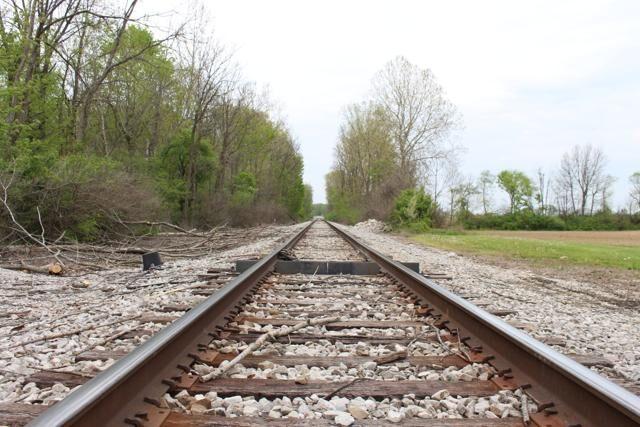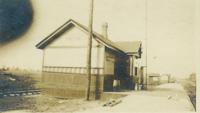-
Train tracks still run through the place where Anita, Indiana, was located. They are now used by the Indiana Rail Road. Google Maps has labeled a random, lonely field just west of Trafalgar “Anita.†But what’s Anita, and why have you never heard of it?
It may seem as if there is a community there, but all that remains now are some railroad tracks. One hundred years ago, this empty field was a bustling center of commerce and an integral part of Johnson County. But where did it all go?
Before the invention of the car, the railroad was the king of transportation. Railroad stations were the foundation of many communities because people looked to capitalize on the influx of travelers. Anita was no different.
In 1906, the now-defunct Indianapolis Southern Railway built a station just west of the small community of Trafalgar. This station would allow people in the area to catch a train to Indianapolis, a trip that would take about two-and-a-half hours. With the lack of major roads, a trip to Indy by any other method would take significantly longer.
But the station needed a name.
A girl named Anita
Ray S. Blinn, a civil engineer who had helped find an ideal location for the stop, proposed naming the station Anita after his infant daughter, Anita Blinn. It was accepted, and Anita, Indiana, was born.
His daughter, now known as Anita Blinn Wenger, later recounted the story in a 1960 letter.
“When I was a little girl in Ohio, my father … told me he had been locating a railroad in Indiana and that he had named a station stop after me,†Wegner wrote. “I grew up knowing that a town was named for me. I was very proud of it.â€
From a station to a town
A photo of the old Anita Station taken from the western side of the building. The station has since been converted into a house in Trafalgar. The station opened for business in 1906. According to Harvey Jacobs in “We Came Rejoicing: A Personal Memoir of the Years of Peace,” you could catch a train to Indianapolis twice a day—there was one at 7:25 a.m. and one at 10:22 a.m. Both were almost always on time.
People flocked to Anita, and the area became a hub for business. During the day, the village was never quiet.
David Pfeiffer, director of the Johnson County Museum of History, describes how trains would often make or break towns at the turn of the century.
“It sort of built up around this train station,†Pfeiffer said. “There’s a farming community there, there was a general store there, but it’s really about that train. … I think these different train lines periodically needed places to stop for their trains, and places kind of sprung up [around them].â€
Not only did trains provide an easy way to get to Indy, but they also became important for local farmers, who could easily ship their goods to the markets in Indianapolis.
On any given day, farmers could be seen loading large metal milk containers onto a nearby train with the help of some of the railroad workers. The station also boasted a wheat elevator, which allowed for easy shipment of the grain.
Anita quickly grew from a simple station into a thriving farm community. Not only did the area become more populated with farmers and houses, but events were also held in and around the station for the locals. The most popular were dances held in the streets on summer nights, including live music and big pitch-in dinners.
Money over community
The station changed ownership in 1911. Its previous owner, the Indianapolis Southern Railway, had failed to pay interest to the Illinois Central Railroad on a bond that the Indianapolis Southern had issued.
The railroad couldn’t pay the interest, and the station was foreclosed. It was bought out by Illinois Central, a railroad behemoth that was more focused on national business than the business of a small farming community.
Things went on as normal for a while. The trains still stopped at the station, and commerce continued to flow unaffected. However, the Illinois Central did not see the value in the small station that the Indianapolis Southern Railway did.
At some point in the late 1920s, residents in the area saw a high-end, glass-enclosed train car making visits to the station: executives from the Illinois Central Railroad. This sparked rumors that the Anita station would be closed.
Fearing their biggest source of income may be ripped away, the community banded together and created a petition to prevent the Illinois Central executives from shutting down the station.
Forty to 50 people signed the petition and sent it off to the executives. The response they received back was surprising.
The executives said they had no plans on shutting down the station and added, “You can ship and receive as usual and the same number of freight trains will be available as always.†The town rejoiced. Their station was saved—or so they thought.
Despite what the executives said, they had no plans for keeping the Anita station alive for long. It simply did not bring in enough money to keep it operating as a passenger stop.
The first step towards axing the station was turning it into a flag stop. A flag stop was one at which trains did not have to stop. Trains would only stop there if someone on the platform or on the tracks flagged them down.
Nobody alerted the station that this would happen. An auditor simply arrived one day and told the station master, “I have come to check you out.†That was the only warning he received before he was fired and Anita became a flag stop.
From there, the station continued operations, but the town could see the writing on the wall. Anita’s station would not last. Now farmers had to flag down trains to ship goods, and passengers bound for Indy had to do the same thing. There was no guarantee a train would stop.
In 1936, the foreman received a notice to vacate the station. All operations at Anita Station were to cease, and the station buildings were to be abandoned, it read. With the closing of the main point of commerce in the town, Anita was quickly forgotten.
“That was really what held the area together.†Pfeiffer said, “It was a bit more isolated, and without that anchor, the community died out.â€
Keeping the spirit of Anita alive
By the 1960s, there was no evidence the town even existed, but it did continue to appear on maps.
That is, until the late ’80s when Johnson County cartographer John Jackson considered removing the name from the map, as there really wasn’t anything there anyway.
Local resident William Hendley would not allow that to happen. He called Jackson to try to convince him to keep the name alive, but he upset him by calling at such a late hour.
Hendley never lived in the town during its heyday, but he had fond memories of exploring the site.
“When I was younger, I had soil maps from 1927 that showed the number of structures in Anita. I used to pace off where the buildings were and tried to map out all of the houses,†Hendley told The Daily Journal in 1989.
Hendley and numerous others who had fond memories of Anita petitioned to keep the town’s name on the map. They somehow convinced State Rep. Woody Burton to introduce a resolution to keep Anita on the state map indefinitely.
“Some of that stuff just gets blown by the wayside. But our kids need to be able to see a little bit of the past,†Burton told The Daily Journal. “It doesn’t cost anybody anything, and I think it’s a good thing,â€
Not only was Anita kept on the map, but Gov. Evan Bayh also proclaimed May 12 to be Village of Anita Day. The area even got a sign, thanks to fundraising efforts by Hendley and his group.
But the marker was later stolen. A new one was erected outside of the Johnson County Courthouse but has yet to return to the location of Anita. It currently sits in storage at the Johnson County Museum of History.
The remnants of Anita
If you go to the site of Anita today, you won’t find much of anything. The railroad is still there but without the stop. It’s now operated by the Indiana Rail Road.
The station sat abandoned for years before being converted into a house and moved to Trafalgar, where it still stands today. The other buildings were torn down or moved over the years.
All that remains are a few newer houses, but there’s no indication that the site used to be a town.
While there may be nothing there now—not even a sign—the spirit of the town will live on forever because of the diligent work of those who cared about the community.
This piece by Franklin College student Elijah Roberson originally ran in campus newspaper The Franklin: thefranklinnews.com.






